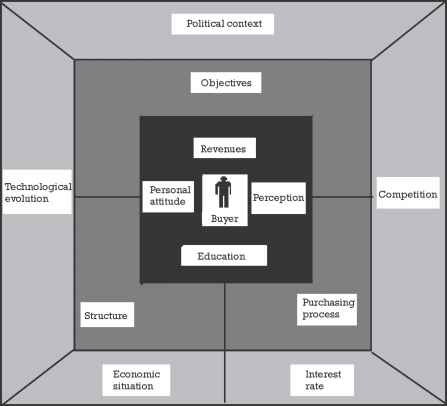Environmental factors
Environmental factors that can be found outside of business customers are political context, economic situation, demand level, competition, and technological evolution. This last dimension is, of course, fundamental in the high-technology sector.
For instance, when the marketing manager of Arianespace analyzes the needs of some of its clients, such as the telecommunication companies, the civilian governments or the 30 biggest military forces in the world (see Figure 3.3), he or she must evaluate the position of rocket launchers in relation to other technologies, such as radio links, electromagnetic waves, or fiber optics, that will strongly determine the demand for satellite launching.
He or she must also study:
► The position of current competitors, Lockheed Martin and Boeing (At which price will Lockheed Martin offer its new rockets? Have

- ^ Environmental factors Organizational factors Personal factors
Figure 3.2 Purchasing criteria groups for high-tech industrial products. The lightest shaded areas represent environmental factors, the darker shaded areas represent organizational factors, and the darkest shaded areas represent personal factors.
Boeing's Delta rockets launch problems been fixed?), as well as new entrants (What about the viability of a new venture such as the Sea Launch platform, an oil rig redesigned as a launch pad, which floats near the equator? How frequently and reliably can this system send rockets into space? What is the business potential of the old Russian ballistic missiles, decommissioned at the end of the Cold War, to become actual competitors?);
► The overall economic situation (for example: What impact will the telecommunication slowdown have on the projects of private telecommunication companies regarding the launching of satellites?);
► The political situation (What are the projects of China and India? So far they have achieved successful launches, but only of small
0 Commercial Q Civilian government | Military
Figure 3.3 The three main categories of customers in the satellite launching business. (Source: Arianespace, 2002 Annual Report.)
satellites. Will they develop bigger rockets? What is the future of Japan's satellite launch business after the H-2 rocket was canceled?).
3.1.2.2 Organizational factors for the purchasing company
As for all industrial products, the client's organizational dimensions must be taken into account in order to make a high-tech product a marketing success.
Every company has its centralized or decentralized organizational structure, its procedures, its objectives, and its politics, all of which can influence the success or failure of the acquisition and the adoption of a new high-tech product. Consequently, the sales force plays a fundamental role in pushing the product through the decision-making system of the purchasing company. The marketing department must supply the sales force with useful reference points.
The marketing department can point out changes in the decision-making process for a particular sector or a type of customer. For example, in the information technology business, MIS managers are no longer always the ultimate decision makers when choosing computers and software; the general management and the users often make these decisions, even in the case of purchasing a large mainframe or big database software.
The marketing manager must also urge the sales force to establish early business relations with potential clients. Actually, certain high-tech

High orbits Medium orbits Low orbits
(television, (spy satellites, (mobile phones, communications) communications) Earth observation)
High orbits Medium orbits Low orbits
(television, (spy satellites, (mobile phones, communications) communications) Earth observation)
products require an extremely long courtship, for example, extending up to 10 years for a rocket launcher or a supercomputer and even 15 years for certain chemical molecules. These time periods are longer when the products are more specific.
The customer must be approached at the moment when a need develops. The sales force must have a firm control of the relationship in order to offer products that satisfy the company and to work with the company regarding the development of the product. If this is not the case, competitors take control.
Another very important case is for purchases that are made by a bidding process, a frequently used procedure for high-tech products in civilian and military industrial markets. Here, a prospect company must be approached very early on, as soon as it shows a need, in order to present the company with a preliminary draft of the solution and to establish a specifications list that will be used as a source document during the bidding process. When this specifications list officially appears, it is already too late to react. For example, in the case of a Request for Proposal (RFP) for supply chain management software, even a specialist such as i2 Technologies, Inc., will have trouble responding to the required specifications if they resemble SAP software. Similarly, Alcatel Space will not be able to offer a satellite if the characteristics are almost an exact copy of the model manufactured by Hughes Space and Communications Co., the American company.
Continue reading here: Managing distributors of hightech products
Was this article helpful?


